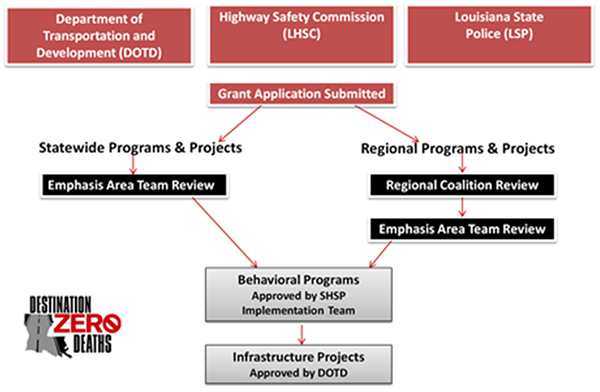Background
Potential stumbling blocks to implementation of Strategic Highway Safety Plans (SHSP) include funding for the projects and programs identified by the safety stakeholders and how to institutionalize project selection and funding over the long term. The Louisiana Department of Transportation and Development (DOTD) is using funds from the Highway Safety Improvement Program (HSIP) to address these challenges while keeping informed of stakeholder roadway safety needs and wants through the overall SHSP structure.
DOTD is using Highway Safety Improvement Program (HSIP) funds and staff to support regional safety coalitions who identify, develop, and implement behavioral and infrastructure road safety programs and projects. The Louisiana approach relies on a data driven decision making, widespread outreach and partnerships with State, regional, and local agencies and organizations, and a focus on addressing traffic related fatalities and serious injuries at the local level—where they occur.
The Approach - How It Works
Louisiana deploys a two-tier approach to SHSP implementation. Statewide initiatives are managed by the SHSP emphasis area teams while other projects and programs are implemented regionally through nine regional safety coalitions. The State finds regional implementation is an effective way to expand the SHSP focus at the local level. Under the DOTD program, HSIP provides funding for:
- Regional safety coordinators, who establish and manage coalitions and develop regional safety plans reflecting SHSP goals, objectives, and proven effective strategies; and
- Statewide and regional strategies and actions in the SHSP or regional safety plans.
Louisiana SHSP Funding Process

Regional coalitions are funded through Metropolitan Planning Organizations (MPOs) to ensure necessary organizational support and continuity. As part of the agreement, MPOs are required to include safety in their Unified Planning Work Program (UPWP), which ensures safety has a place at the table. The effort started with a pilot program in the South Central region (see 2013 Noteworthy Practice) in conjunction with the National Highway Traffic Safety Administration's Safe Communities model. That program was successful, particularly in achieving reductions in alcohol-related and unrestrained serious injuries, and the approach was adopted and taken statewide.
DOTD recognized the need to select the appropriate people as regional coordinators and enlisted the help of MPO directors and staff to identify potential candidates. The coordinators generally have a marketing/public relations background and a demonstrated ability to work effectively with large groups. Once the coordinators were hired, DOTD conducted a training session and provided information on coalition building, data collection and analysis, meeting facilitation and management, presentation skills, evaluation, and marketing. Regional safety coordinators also participate in monthly conference calls to share ideas and information.
The program is administered by DOTD in coordination with the Louisiana Highway Safety Commission (LHSC) and the Louisiana State Police (LSP). Individuals or groups at the State or regional level interested in funding complete an application. Statewide projects are reviewed and approved by the relevant SHSP emphasis area team. Those designed to impact a region are reviewed and approved by the relevant regional team and sent to the appropriate emphasis area team for their consideration. The SHSP Implementation Team approves behavioral safety programs and projects and DOTD approves infrastructure related projects.
Key Accomplishments
- Statewide SHSP emphasis area teams rely on the regional teams as a method for implementing programs and projects. Often ideas are pilot tested in one region and if successful, replicated statewide through the regional system.
- The DOTD Secretary publically supports the effort and recognizes the need for the agency to provide financial and technical assistance for both infrastructure and behavioral safety projects.
- LHSC supports regional safety coalitions through mini-grants for impaired driving and occupant protection programs, and the LSP Superintendent directs the Troop Commands to actively participate in the coalitions.
- Regions use data-driven, multidisciplinary Road Safety Audits (RSAs) as a way to prioritize and implement low-cost engineering solutions at high crash intersections and horizontal curves.
- The training and technical assistance needs for the regional and local stakeholders has led to an enhanced Local Technical Assistance Program (LTAP) program, and the creation of the Louisiana Center for Transportation Safety (LCTS), which provides support to the regions in the areas of workforce development and research, training, and technical assistance.
Results
- Traffic related fatalities continue to decrease in Louisiana. After a slight increase in 2011, fatalities continued to move in the right direction in 2013 and 2014. Serious injuries have continued a downward trend.
- Since DOTD began contributing HSIP funding for increased enforcement, safety belt use has gone from 77 percent to 84 percent.
- The initial regional pilot project in the South Central Region of the State has achieved a 17 percent decrease in fatalities.
Key Accomplishments and Results
Measured reductions in alcohol-related serious injuries as well as in serious injuries resulting from lack of seatbelt use.
Contact
Dan Magri
Safety Highway Administrator
Louisiana Department of Transportation and Development
225-379-1200
Dan.Magri@la.gov
